Winter Solstice 2011
In this Edition:
Hex Announcements
Kitchen Medicine & Magic: Yule
Baking Springerle Cookies
Runic Reflections: Othala
Hex Issue 9 Autumn/Winter 2011 is Here!
Support Hex! We are a community-supported not-for-profit publication. You can support us by heading to http://hexmagazine.com/subscribe/ and ordering magazines, CDs, and prints, and by spreading the word to all like-minded folk!
* * * * * *
Hex Folk Market (www.hexfolkmarket.com) is here! Join our online market community in celebration of folk ways and sustainable living. Browse through our selection of international merchants or set up your own shop for free!
* * * * * *
Leather Bound Limited Edition of Issues #5–8 + CD!
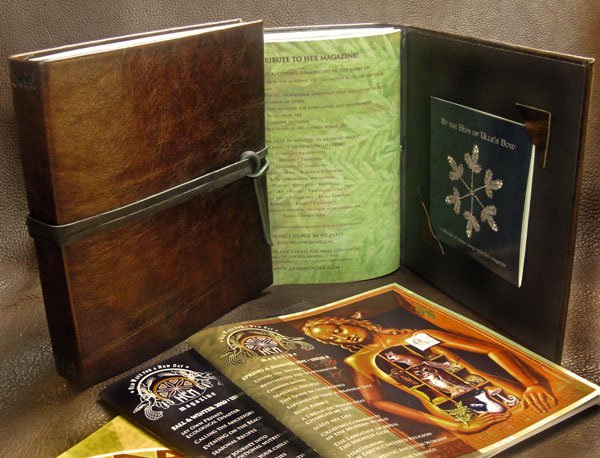
An edition of 13, and signed by the artisan (Jason Hovatter) and editors of Hex.
Each copy is $100 + shipping. If you want to order send me an email: arrowyn@hexmagazine.com.
It’s first come…first serve!
Note: Issue #5 is sold out – this is a small reprint run.
All proceeds go to Hex Press to support its continued effort to provide folks with an excellent volunteer-based, community-supported, not-for-profit publication.
* * * * * *
Feeling Hexy?
Hex is putting out an initial call for Heathen Erotica. For a side project, not a regular issue. It will be published when we get enough material.
Accepting submissions for stories, poetry, art, photography, recipes, whatever. You can submit under your own name or a nom de plume. The usual high standards of quality apply! IE: if it’s smut, it better be really good smut!
Send submissions to submissions@hexmagazine.com
* * * * * *
Kitchen Medicine & Magic ~ Yuletidings!
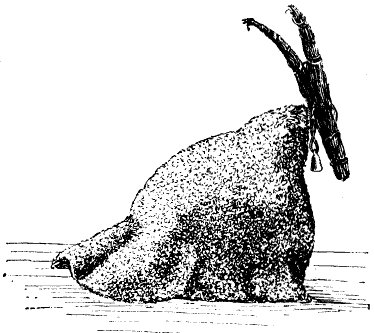
Julmond (MoHG – 1-31 Dec.)
Aerrageola (AS – ‘Before Yule’)
Jolmanudr (Ice – ‘Yule Month’)
Heilagmonath (Fr – ‘Holy Month’)
Yule (Asatru – 1-31 Dec.)
(As published in Zeitgeist Winter Supplement 2005)
The first frost passed through the lands last night, which is a good thing for collards and kale which are twinkling in the garden from the tiny ice crystals. These brassica family plants were well known during saga times and were very useful to the table since they can live and even thrive during cold temperatures – and usually get sweeter after the first frost. Out in the surrounding forest Sunna lights up the pines from her seasonally lower angle in the sky, exposing their long trunks to the light. The trees and shrubs reflect this light, hitting them with movement within its shadows. One who knows of fairies and elves might decide to believe that just out of sight are beings of mysterious origin.
Heathens know that in some cases these unknown shadowy beings can be named and should be either honored and welcomed, or else guarded against, during the coming Yule season. After all the Wild Hunt which began at Winters Night is said to intensify between Mothers Night and Twelfth Night!
Mothers Night marks the beginning of a High Holy time for most Heathens. One old way to honor the Mothers on Solstice Eve is to create a wreath to bring luck to the household during the Twelves. Try using natural and local materials to create your wreath, and get the kids involved. Perhaps you can identify a plant or two that looks nice in the winter landscape. This wreath can be used in your Mothers Nights Blot or Sumbel ceremonies as if it were the drinking horn by passing it from person to person so each can contribute something of their ancestors. Keep the wreath through the Twelves and burn it as you stay up on the Twelfth Night Fire as an offering.
This year we will be remembering Great Grandmother Florence who chose to follow the Wild Hunt, passing into the next world in November at the age of 93. Grandma’s side of the family was filled with blond and blue eyed German and Pennsylvania Dutch blood. She was a marvelous cook, gardener, and all around strong woman. Below I have presented her famed noodle recipe.
The latest issue of Hex Magazine, Fall & Winter 2011, is hot off the presses and jumps right in to explore some of the topics of the season. The first story I read was “How Hex Magazine Changed My Life,” in which Henry, one of the Editors for Hex, relates a tale that unites love across the great ocean water and a wedding atop a mountain in Oregon to Arrowyn, one of the magazine’s founding editors! Congratulations!
This time of year is also the time when some old ways tell us sooth or prophecy might be important. Siegfried Goodfellow explores this topic in “The Importance of Sooth in Heathenism.” Through explorations of the Havamal, the World Tree, and Odin (who is noted to have had names like Sooth and Getter of Sooth), the image of sooth seem to be an important part of how Heathens connect with life: “…we have been on the world tree ourselves, and have thus experienced the traces of the interflow of everything, and that therefore, it lives within us, waiting to be awakened, through remembrance, through contact with the sensory materials about us.”
Swain Wodening, long time contributor to Heathen learning, brings us a look into “The Sacred and The Holy” among early Heathens and their place as aspects of kinship, community, and personal relationships.
This issue of Hex also gets in touch with readers thorough Elizabeth Griffin’s poll investigating real-life Heathenism in “Old Ways and New Days: A Multi-Issue Poll of Heathen Thought and Practice.” The questions explored themes including: sacrifice without bloodletting; using objects in cars as compared to warhorses, which were decorated with charms, etc; and readers’ comments on their relationships or lack thereof within the internet community. Readers also share their own short stories in “Winter Traditions,” which includes Henry’s tale of Ullr on the Chairlift, While Hunter Yoder brings us the stories of “Six Questions to Six Heathen Hexologists and their Six Hexes.”
Regular contributor Antonius Block continues to connect stories found in myth and history in “The Language of Myth: Sky-Father, Folk-King, and Warlord.” Antonius reminds us that “…language is the vessel in which myth is transported from one generation to the next, making the speech of our ancestors the Language of Myth.”
Last but not least is “Speckled Snake, Brother of Birch: Amanita Muscaria Motifs in Celtic Legends,” an epic and well-researched adventure into this colorful and alluring member of the mushroom family by Erynn Rowan Laurie and Timothy White.
As always Hex has some great recipes and poetry and artwork. Help support Heathen businesses: consider sharing a subscription to Hex Magazine with someone you know!
May your Yule Season be blessed with favor by your ancestors and your family be safe and prosperous in the New Year!
Grandma’s Noodles
Whip together:
1 beaten egg
2 T. milk
1 t. salt
Add: 1 cup flour and knead lightly
Roll out to desired thickness and let sit to dry and relax gluten for 20 minutes covered, or longer in a cool area.
Roll up jelly roll style and cut into strips about half an inch wide.
Sprinkle with some flour and toss lightly, then let dry another few minutes.
Cook for only a few minutes in rapidly boiling salted water. They should be done when they float to the surface.
Or cook directly in a flavored broth and serve in the broth. Grandma cooked her noodles in the broth from a pot roast. Yummy!
Hail Day!
Teresa L. Hedgewife
Pinecone Hearth
* * * * * *
Springerle: Molded Anise-Seed Cookies
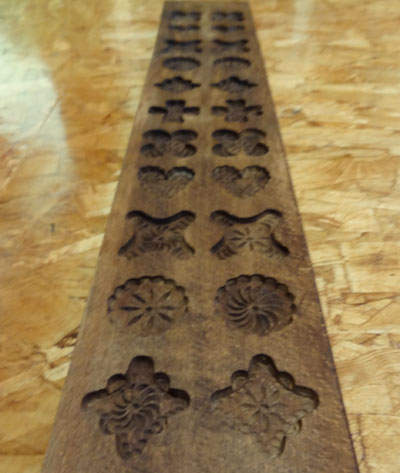
Several years ago at a rummage sale I found this beautiful wood plank with sunwheels and flowered hearts hand-carved into it. I had no idea what it was but I had to have it. Then some time later I stumbled upon a recipe for springerle cookies in my German cookbook and figured that this is what the mold was made for. It took a couple tries of this recipe to get it right, and I still have difficulty if I go too long without making them, but the effort is worth it. When they turn out right they are beautiful and delicious! A special old-fashioned festive treat.
Ingredients:
2 T butter
1 c. anise seeds
2 eggs
1 1/4 c. sweetener (I use honey)
1 t. finely grated lemon peel
A drop of vanilla
3 c. flour (I use whole-grain Spelt flour)
Cookie molds
Method:
With a pastry brush or finger coat two large baking sheets with a tablespoon of butter each. Sprinkle the butter evenly with the anise seeds and set the pan aside.
In a large bowl, beat the eggs with a whisk or a rotary or electric beater until they are thick and lemon-colored. Gradually add the honey or other sweetener and continue until the mixture is thick enough to fall back on itself in a slowly dissolving ribbon when the beater is lifted form the bowl. Beat in the lemon peel and vanilla, and then the flour, a cup or so at a time.
Shape the dough into a ball and place it on a lightly floured board. If it feels sticky, work additional flour into it with your fingers, adding a tablespoon at a time. Then knead the dough with lightly floured hands for 10 minutes or so, until it is smooth and pliable.
Sprinkle the board with flour again, pinch off half of the dough and roll it out into a rectangle about 1/4 inch thick. Sprinkle a springerle mold or springerle rolling pin evenly with 2T of flour and rap it sharply on a table to remove the excess. Then press the mold down or roll the pin firmly across the dough, to print the pattern on it as deeply and clearly as possible. For my mold it was easier to press the dough in from the top, but others are easier to press into the dough.
Cut the cookie squares apart with a small sharp knife or ravioli cutter (for my mold it was easier to pinch the excess dough off the shape with my fingers). Place them an inch apart on the prepared baking sheets, on top of the anise seeds. Roll and cut the rest of the dough similarly. You must work quickly because the dough dries rapidly. Set the cookies aside uncovered at room temperature for 24 hours. After the resting time press the cookies gently into the anise seeds.
Preheat the oven to 250F and bake the cookies for 20–30 minutes, or until they are firm but not brown. With a large metal spatula, transfer the cookies to a cake rack to cool. Then set them aside uncovered for a few days to soften.
They may be stored for several weeks in tightly sealed jars or tins. Save the anise seeds remaining on the baking sheets and scatter them over the bottom of the cookie jar or tin. Their flavor will permeate the cookies as they stand.
Note: It might be difficult at first but practice will improve the results, it is not a good recipe for beginner cooks. At the very least, don’t try it out the first time for a special occasion.
~ Arrowyn Craban Lauer
Adapted from The Cooking of Germany, Time Life Books
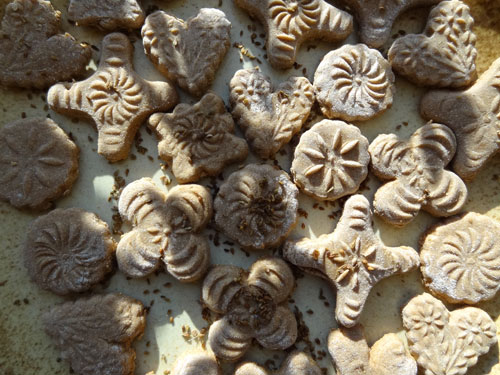
Resources:
Here’s a great video for help with the molding part:
http://www.springerlejoy.com/video2.html
There’s some really nice molds here:
http://houseonthehill.net/cookie-molds/
A ton of molds here. Some nice ones like these stars:
http://www.springerlejoy.com/prostar4.html
* * * * * *

•Othala•
Old English Rune Poem
Ethel (Homestead) is over-dear to each man,
if he may there justice and courtesies
enjoy in a mansion in frequent prosperity.
~ Rune poem translations by Sweyn Plowright,
http://www.mackaos.com.au/Rune-Net/Primer/
The purpose of a myth, a story, a symbol, a work of art, a memory, a conversation, of any communication at all, is to draw us out of the habituation of everyday doing and being.
Consider myth, for example. A symbolic parable which communicates on many layers and which offers many competing (yet also complimentary) interpretations. It does not happily render itself to our linear, conscious, controlled expectations and assumptions. It declines to accept the simplified constructs of self-evident business-as-usual. It confounds and dares and provokes.
What, then, is this myth of home that Othala invokes? So much meaning is laden into so simple a symbol: being at rest in a comfortable home. It seems so mundane, so basic, yet it is the very heart of so many hopes and fears. There’s something wired deeply into human physiology, a profound need for comfort, solace, relief from the struggle for survival that carries us from birth to grave.
Home. To be at home. To be able to find oneself in a place that feels comfortable. To be able to recognize oneself in one’s environment. To feel not alienated, but at ease, without need for self-consciousness or striving. Take a moment to dwell on these ideas. Feel the way such thoughts ease your breath, your muscles, the currents and tides of your mind. The simple delight of home touches on and sates even our deepest needs.
Home is more than a physical place, a community, a dwelling, a gathering of familiar faces and voices. It is the gathered memories and memorials of the same; reminders of our worth, our value, our capacity to trust that we will have enough and be enough for the living of life. Home is not just a domain in the present, but a hall in which the past may also reside.
If the past lives in our memories, our minds, and our emotions, then it follows that so does home. Othala resides within each person. How ramshackle or well-maintained this inner dwelling becomes depends on how well we make peace with past hurts and how well we appreciate past blessings. Indeed, our ability to sift the bad from the good is essential for the cultivation of a strong sense of Othala.
Othala lives also in our relationships, of course. Isolation is a sure recipe for sadness. The more we are able to find ourselves reflected in the gaze of those around us, the more at home we will feel. This is anything but a trivial theme on which to reflect: home is in every kind word that I share with you and that you share with me.
As a rune, Othala sometimes conjures a sense of exclusivity. Yet its significance runs deeper than this. With curiosity and courage, home can be found in even fleeting exchanges and alien circumstances. It transcends the trappings and structures that we try to build around it. It is always more than we expect or imagine. It wants to find us, and our task is mostly to let it do so, to treat it with a light touch.
For these and many other reasons, calling on Othala is a sacred act. To do so builds trust in life itself.
* * * * * *
By the Hum of Ullr’s Bow: Winter Songs Compilation CD
is still available!
Bands on the compilation CD include:
• A Minority of One • Allerseelen • Andrew King
• At the Head of the Woods • Beastianity • Hamramr • Irij
• Ironwood • Ruhr Hunter
• Sangre Cavallum • Sieben
• Steve von Till • Svarrogh • Waldteufel • Wardruna
You can read more about the artists here:
http://hexmagazine.com/harvest/winter-songs-cd/
* * * * * *
: Issue Six Almost Gone! :
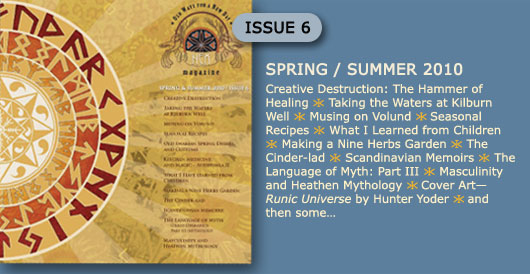
Issues One, Two, Three, Four, & Five are sold out!
We are running low on copies of Issue Six, get in while you can.
Order at:
http://hexmagazine.com/subscribe/
* * * * * *
Until Imbolc, may you and your household be blessed and kept. Hail!
~ HEX Magazine
* * * * * *
We are currently looking for:
• submissions
• funding
If you are interested in applying or have any suggestions,
contact: info@hexmagazine.com
* * * * * *
Due date for Autumn 2012 submissions
is Spring Equinox 2012
Support your community while exposing like-minded folk to your goods and services…
Advertisements must be relevant to HEX readers, and inclined toward a Heathen aesthetic. Prices listed are for completed AD files. If you need additional graphic design, we can help. Just contact us about our design fee.
>I< HEX >I<



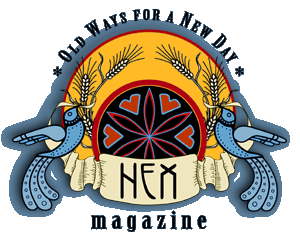
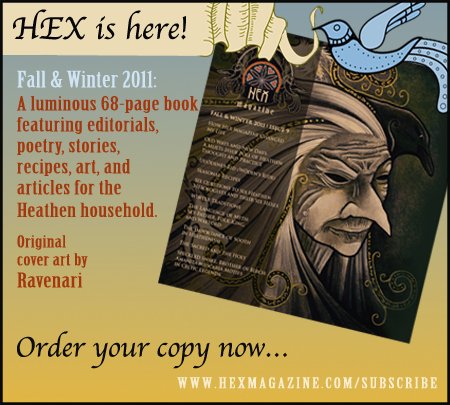
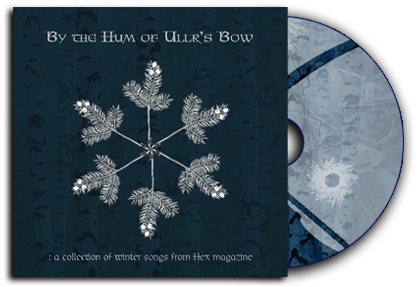






Leave a Reply